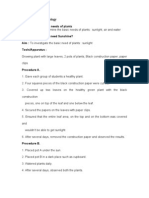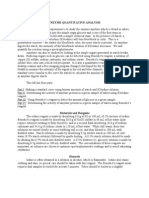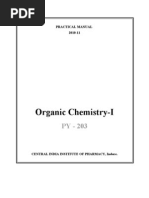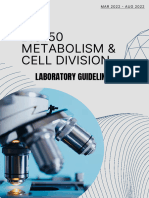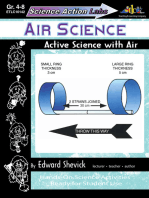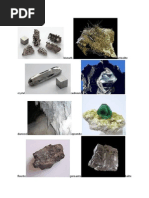Peka Paper 3
Peka Paper 3
Uploaded by
Bear Bear LeongCopyright:
Available Formats
Peka Paper 3
Peka Paper 3
Uploaded by
Bear Bear LeongOriginal Description:
Copyright
Available Formats
Share this document
Did you find this document useful?
Is this content inappropriate?
Copyright:
Available Formats
Peka Paper 3
Peka Paper 3
Uploaded by
Bear Bear LeongCopyright:
Available Formats
M&S LEARNING CENTRE 0122026649
(F4Chapter 8)
Hydrilla sp. is a multicellular organism found in the water pond. The
population distribution of Hydrilla sp is affected by abiotic factors such as
light intensity, humidity and nutrient content.
Hydrilla sp adalah organisma multisel yang dijumpai di dalam kolam.
Taburan populasi Hydrilla sp dipengaruhi oleh faktor-fakt
A group of student has carried out an experiment to study the effect of light
intensity on the population growth of Hydrilla sp. The mass of Hydrilla sp is
kept constant at the beginning of experiment. Four bulbs with different
watts were used and the study was done for 6 weeks.
Satu kumpulan pelajar telah menjalankan eksperimen untuk mengkaji kesan
keamatan cahaya ke atas tumbesaran Hydrilla sp. Jisim Hydrilla sp
ditetapkan malas pada permulaan eksperimen. Tiga mentol berlainan kuasa
digunakan dan kajian mengambil masa selama 6 minggu.
Design an experiment in the laboratory to study the above effect. Your
experimental planning should include the following aspects:
Rancang satu eksperiment dalam makmal untuk mengkaji kesan diatas.
anda hendaklah mengandungi aspek-aspek berikut:
Problem Statement
Pernyataan Masalah
M&S LEARNING CENTRE 0122026649
Hypothesis.
Hypothesis
Variables
Pembolehubah
List of materials and apparatus.
Senarai Radas dan bahan
Experimental procedure.
Prosedur eksperiment.
Presentation of data.
Persembahan data
[17 marks]
Problem statement:
1. What is the effect of light intensity on the mass of Hydrilla sp?
Hypothesis:
1. As light intensity increases, the higher the mass / height of Hydrilla
sp.
Variable:
Manipulated variable: Light Intensity // Different Watts / power of bulbs
Responding variable: Mass / height of Hydrilla sp
M&S LEARNING CENTRE 0122026649
Controlled variable : Initial mass of plant / Hydrilla sp // number of
weeks/ duration
Materials : Hydrilla sp plant, pond water, tissue paper
Apparatus : Beakers, marker pen, light bulbs (20W, 40W, 60W, 100W),
weighing machine / metre rule, forcep
Example of Procedure.
1. 250ml of pond water is placed into 4 beakers ,
(K1)
which are labelled as A,B,C and D
2. 10 pieces of Hydrilla sp / aquatic plants are cut of at the same
length
(K2)
The height/ length are recorded
(K1)
3. The Mass of Hydrilla sp is then measured by using a weighing
Machine
(K1)
4. Two plants species / Hydrilla sp are placed / added to each of the
beakers by using a forceps
(K1)
5. The beakers are placed at different bulb power as follows
Beaker A for 20 Watts
Beaker B for 40 Watts
Beaker C for 60 Watts
Beaker D for 100 Watts
(K3)
respectively
6. Both plants / Hydrilla sp are taken out from each beaker every
week.
(K1)
M&S LEARNING CENTRE 0122026649
7. The Hydrilla sp are dried out using tissue paper / cloth
(K5)
and weight using a weighing machine /balance.
The mass / height of plants are recorded
(K4)
8. This observation was carried out for 6 weeks
(K2)
9. All the readings of mass are tabulated in a table and the average
reading
are calculated
.
(K4)
Tabulation of data:
Power of
bulbs /
Watts
Mass/ length of Hydrilla sp
(g /cm)
1
Average (g /
cm)
20
40
60
100
1.Determine the population of birds.(form 4 Chapter 8)
Objectives of study: To investigate and estimate the population of birds.
Hypothesis:
The population size of birds can be determined by:
M&S LEARNING CENTRE 0122026649
Variables:
Manipulated variable: Birds which are captured in the first and second
Responding variable: Birds are marked
Controlled variable: Places of experiment, species of birds
Apparatus and materials:
Light ring, fruit-eating birds that have determined and special net that can
cover the area of sampling
Technique used:
Capture, mark, release and recapture
Procedure:
1. A special net is put up at a sample area that has a lot of birds to be
sampled.
2. A total of 120 birds are captured and a small ring is placed at their
feet. Then, they are released.
3. After 2 days, 100 birds are recaptured randomly.
4. The number of birds that are tagged are counted.
5. All the information are recorded.
Tabulation of data:
Number of birds at 1st capture:x= 120
Number of birds at 2nd capture:y=100
Number of birds tagged with small rings: z
Estimation of the number of birds in the sample area =
=
Conclusion:
M&S LEARNING CENTRE 0122026649
Number of birds can be determined by capture, mark , release and recapture
technique.
The population of birds =
2.Effect of pH on the enzyme activity of pepsin(f4 c4)
Problem statement: what are the effects of pH on the activity of pepsin?
Aim: To study the optimum pH medium for the pepsin to perform well.
Variables:
Manipulated variable: pH of medium
Responding variable: Rate of enzymatic reaction
Constant variable: Volume and concentration of albumen suspension
Hypothesis:
The optimum pH for the activity of pepsin is an acidic medium of pH3.
Materials:
Albumen suspensions, 1% pepsin solution, 0.1M hydrochloric acid, 0.1M
Sodium hydroxide solution and distilled water.
Apparatus:
Beakers, droppers, thermometers, test tubes, 5ml syringes, pH paper, wire
gauze, a stopwatch and a test tube rack.
Technique:
Observe the condition of mixtures before and after 20 minutes.
Procedures:
1. An albumen suspension is prepared by mixing the egg white from an
egg with 500ml of distilled water. The suspension is boiled and cooled
down.
2. Three test tubes are prepared and labeled P,Q and R respectively.
M&S LEARNING CENTRE 0122026649
3. A syringe is used to add 5 ml of the albumen suspension to each test
tube.
4. 1ml of 0.1M hydrochloric acid and 1ml of pepsin solution are added
to test tube X.
5. 1ml of 0.1M sodium hydroxide solution and 1ml of pepsin solution
are added to test tube Y.
6. 1ml of distilled water and 1ml of pepsin solution are added to test tube
Z.
7. All the test tubes are immersed in a water bath maintained at 37oC for
20 minutes.
8. The observations are recorded in a table.
Tabulation of data:
Test tube
pH
X
Y
Z
Mixture
Mixture after 20
At the beginning minutes
of the
experiment
3
7
8
3. Effect of temperature on the enzyme activity of pepsin(f4 c4)
Problem statement: what are the effects of temperature on the activity of
salivary amylase?
Aim: To study the optimum temperature for the salivary amylase to perform
well.
Variables:
Manipulated variable: temperature
Responding variable: Rate of enzymatic reaction
Constant variable: Volume and concentration of starch suspension
Hypothesis:
The rate of activity of salivary amylase on starch increases with the increase
in temperature until it reached the optimum temperature of 37oC.
M&S LEARNING CENTRE 0122026649
Materials:
1% starch suspension, saliva solution, iodine solution , ice and distilled
water.
Apparatus:
Beakers, test tube, syringes, droppers, glass rods, while tile with grooves,
thermometers, a Bunsen burner, a tripod stand, a test tube rack, a wire gauze
and a stopwatch.
Technique:
Test for the presence of starch using the iodine test. Measure and record the
time taken for hydrolysis of starch to be completed with a stopwatch.
Procedures:
1. The saliva collected in a beaker is diluted with an equal volume of
distilled water.
2. 5ml of 1% starch suspension is added to 5 test tubes labeled
A1,B1,C1,D1,and E1respectively by using a syringe.
3. 2ml of saliva solution each is added to another set of test tubes,
labelled A2,B2,C2,D2 and E2 respectively, using a new syringe.
4. Test tubes A1 and A2 are immersed into different water baths with
temperatures 0oC.
5. Steps 4 are repeated using test tubes B1 and B2, C1and C2, D1and D2
and E1 and E2 with temperatures 28oC, 37oC, 45oC and 60oC.
6. The test tubes are left for 5 minutes.
7. A drop of dilute iodine solution is placed into each groove of the
white tile.
8. After 5 minutes, the starch suspension in test tube A1 is poured into
saliva solution in test tube A2.
9. The mixture is stirred using a glass rod. A stopwatch is activated and
the time is recorded as zero minute.
10.A drop of mixture from test tube A2 is immediately placed in the first
groove of the tile containing the iodine solution.
M&S LEARNING CENTRE 0122026649
11.The iodine test is repeated every minute for 10 minutes. The dropper
is rinsed in a beaker of distilled water after each sampling.
12.The time taken for the hydrolysis of starch to be completed is
recorded.
13.The test tubes containing the mixture are kept in their respective water
baths throughout the experiment. Steps are repeated for test tubes
B1,C1,D1 and E1.
Tabulation of data:
Test tube
Temperature Time taken for the
(oC)
hydrolysis of starch to be
completed (minutes)
A2
0
B2
28
C2
37
D2
45
E2
60
Rate of enzymatic reaction
(min-1)
4. Level of pollution(f4C9)
Problem statement: What is the level of pollution in different sources of
water?
Aim: to investigate the level of pollution in several samples of water from
different sources.
Variables:
Manipulated variables: Water samples
Responding variables: time taken for the methylene blue solution to
decolourise
Fixed variable:Concentration of methylene blue solution
Hypothesis: river water is the most polluted of the samples of water
collected.
M&S LEARNING CENTRE 0122026649
Materials:
Methylene blue solution (0.1%), water samples from river, pond, drain, pipe,
well and distilled water
Apparatus:
250ml reagent bottles with stoppers, beakers, syringes and stopwatch
Technique:
Measure and record the time taken for the methylene blue solution to
decolourise with a stopwatch
Procedure:
1. Water samples are collected from fives different water samples.
2. The reagent bottles are P,Q,R,S,T and U.
3. Each reagent bottle is filled with 100ml of water samples respectively.
4. A syringe is used to add 1ml of methylene blue solution to the base of
water samples.
5. The reagent bottles are closed quickly and placed in a dark cupboard
and the stopwatch is activated.
6. The bottles are examined from time to time.
7. The time taken to decolourise the methylene blue solution is recorded
for all the water samples.
8. The results are recorded in a table.
Tabulation of data:
Reagent bottle
Water sample
P
Q
R
S
T
U
Pipe water
Drain water
River water
Pond water
Well water
Distilled water
Time taken to
decolourise the water
sample (s)
M&S LEARNING CENTRE 0122026649
6. Effect of pH affect the activity of yeast(f4c7)
Problem statement: How does pH affect the activity of yeast?
Aim: To study the effect of pH on the activity of yeast?
Hypothesis: the activity of yeast is the optimum in acidic medium.
Variables:
Manipulated variable: pH value
Responding variable: the height of coloured liquid in the manometer
Constant variable: volume of yeast suspension
Materials:
Yeast suspension, glucose solution, coloured liquid, distilled water,
hydrochloric acid solution, sodium hydroxide solution, pH paper
Apparatus:
Beakers, glass tube, clips, rubber stopper, rubber tubing, retort stand,
manometer tube, string, measuring cylinder, stopwatch
Techniques used:
Measure and record the height of coloured liquid in the manometer using
a ruler
M&S LEARNING CENTRE 0122026649
M&S LEARNING CENTRE 0122026649
7. Effect of carbon dioxide on the rate of photosynthesis(F4C6)
Problem statement: Does the concentration of carbon dioxide affect the
rate of photosynthesis?
Hypothesis: The higher the concentration of carbon dioxide, the higher
the rate of photosynthesis in aquatic plant.
Manipulated variables: concentration of carbon dioxide
Responding variable: Rate of photosynthesis
Constant variable: Type of aquatic plant
Materials: Hydrilla sp, sodium hydrogen carbonate solution, distilled
water, and plasticine
Apparatus:
Stopwatch, measuring cylinder, ruler, boiling tube, beaker, filter funnel,
capillary tube, rubber tubing, light source and paper clip
Procedure:
1. Fill a boiling tube with 150ml of 1% sodium hydrogen carbonate
solution.
2. Fix a paper clip to a sprig of a Hydrilla sp.
M&S LEARNING CENTRE 0122026649
3. Submerge the aquatic plant into the boiling tube.
4. Put the boiling tube into water bath at room temperature.
5. Place the boiling tube at a distance of 50cm from a lighted bulb.
6. Put aside the boiling tube for 5 minute.
7. Start the stopwatch.
8. Count the number of bubbles release in 20 minutes.
9. Record the result in table.
10.Repeated steps 2 until 9 using 2%,3% and 4% of sodium hydrogen
carbonate solutions.
11.Calculate the rate of photosynthesis.
Tabulation of data:
Concentration of
sodium hydrogen
carbonate solution
(%)
1
2
3
4
Number of
bubbles released
in 20 minutes
Rate of
photosynthesis(number/minutes)
8. The Effect of wind on the rate of transpiration(F5C1)
Problem statement: what is the effect of wind on the rate of transpiration?
Aim: to study the effect wind on the rate of transpiration?
Hypothesis: the fastest the speed of air movement, the higher the rate of
transpiration.
Materials:
Leafy shoots of balsam plant ,Distilled water, Vaseline
M&S LEARNING CENTRE 0122026649
Apparatus:
Capillary tube, Rubber tubing, Stop watch, Beaker, Tissue paper, Marker
pen, Fan
Technique:
Record the time taken for the air bubble to move a distance of 5cm by using
stopwatch.
Procedure:
1. A leafy shoot is cut under water and the cut end is kept in the water.
2. The capillary tube and the rubber tubing are filled with water and the
leafy shoots is inserted into the rubber tubing.
3. The leaves are wipe dry and some Vaseline is put around the each
ends of rubber tubing to make it air tight.
4. The photometer is placed at a beaker of water at the room temperature
for 5 minutes to allow water to move up the capillary tube.
5. A section of capillary tube is marked A and B a distance of 5cm.
6. The capillary tube is lifted from the beaker and the rubber tubing is
pressed gently to squeeze out a drop of water from the capillary to
trap air bubble in the tube.
7. The capillary tube is placed back into the beaker of water and kept
upright using the retort stand.
8. The photometer is placed under slow speed of fan for 10 minutes.
9. The time taken for the air bubbles to move from A to B is recorded by
using the stopwatch.
10.Steps 5 to 8 are repeated twice to get the average.
11.The experiment is repeated under medium and strong speed of fan.
12.The results are recorded in the table.
13.The rate of transpiration is calculated.
Tabulation of data:
M&S LEARNING CENTRE 0122026649
Wind
speed
Readings (min or s)
First
second third
average
Rate of
transpiration(cm/min)
Slow
Medium
Fast
9. Concentration of vitamin C(F4C6)
Problem statement: Does fresh guava juice contain higher
concentration of vitamin C than exposed guava juice?
Aim: To determine the concentration of vitamin C in fresh guava juice
and exposed guava juice.
Hypothesis: fresh guava juice contains higher concentration of
vitamin C compared to exposed guava juice.
Apparatus:
Test tubes, beaker, syringe with needles, stopwatch
Materials:
0.1% ascorbic acid solution, DCPIP solution, fresh guava juice,
exposed guava juice
Technique :
Measure and record the volume of guava juice needed to decolourise
1ml of DCPIP solution by using syringe
Manipulated variables: type of guava juice
Responding variable: volume of fruit juice need to decolourise 1ml of
DCPIP solution
Constant variable: Volume of DCPIP solution
Procedure:
1. Fill a test tube with 1 ml of DCPIP solution using a 5 ml syringe.
M&S LEARNING CENTRE 0122026649
2. Fill a 5ml syringe with 0.1% ascorbic acid solution.
3. Place the needle of the syringe into the DCPIP solution.
4. Add the ascorbic acid solution to the DCPIP drop by drop , stirring
gently with the syringe needle until the DCPIP solution becomes
colourless.
5. Repeat the steps 1 to 5 using fresh guava juice and exposed guava
juice.
6. Tabulate the result. Calculate the concentration of vitamin C in
each guava juice using the formula=
Tabulation of data:
Solution
Volume of fruit
juices need to
decolourise
DCPIP solution
Ascorbic acid
Fresh guava
juice
Exposed guava
juice
Concentration of
vitamin C is
guava juice
10. Concentration of carbon Dioxide (F4C7)
Problem statement: What is the effect of different activities on the
content of carbon dioxide?
Hypothesis: The more vigorous the activity, the higher the percentage of
carbon dioxide in the exhaled air.
M&S LEARNING CENTRE 0122026649
Aim: To investigate how the type of activity affect the concentration of
carbon dioxide in exhaled air.
Procedure:
Tabulation of data:
M&S LEARNING CENTRE 0122026649
11. Determine the size of molecules that can diffuse through a semi
permeable membrane(F4C3)
Aim: to study the size of molecules that can diffuse through a semipermeable membrane
Problem statement: What are the size of molecules able to diffuse
through the semi permeable visking tubing?
Hypothesis: The smaller the size of molecules, the easier the molecules
pass through the semi permeable membrane.
Manipulated variables: Size of molecules
Responding variable: The colour change of Benedicts solution
Constant variable: Volume of starch suspension and glucose solution in
the visking tube
Apparatus: Beaker, Test tube, Bunsen burner, measuring cylinder,
stopwatch
Materials: Benedicts solution, Iodine solution, visking tube, starch
Suspension, glucose solutions, distilled water
Procedure:
1. A visking tube 8cm is soaked in water for 5 minutes to soften it.
2. The visking tube is tied at one end of the tube tightly with a piece of
thread.
3. Visking tube is filled with 10ml glucose solution using a syringe.
M&S LEARNING CENTRE 0122026649
4.The other end of the tube is tied tightly with a piece of thread.
5.The outer surface of the visking tube is rinsed with distilled water.
6. The visking tube is immersed into a beaker filled with distilled water.
7.AFTER 20 MINUTES, a Benedicts test is carried out on the distilled
water outside the visking tube in the beaker.
8.Steps 1-6 are repeated by using starch suspension.
9. 7.AFTER 20 MINUTES, an Iodines test is carried out on the distilled
water outside the visking tube in the beaker.
10. The result of both tests are recorded in a table.
Tabulation of data:
Solution in the visking
tube
Glucose solution
Food test on the liquid outside visking tube
Benedicts test
Iodine test
Starch suspension
12. Osmoregulation (F5C3)
Problem statement: What is effect of volume of water intake on the
volume of urine produced?
Hypothesis:
As the volume of water intake increases, the volume of urine produced
increases.
Manipulated variable: Volume of water intake
Responding variable: Volume of urine collected
Constant variable: plain water, student
Appratus: Beakers, cup, measuring cylinder, stop watch
Specimen: student
M&S LEARNING CENTRE 0122026649
Materials: drinking water
Procedure:
1. A student is chosen and instructed to empty his bladder before the start
of experiment.
2. Measure 200ml of plain water and put it into a cup.
3. A student is given 200 ml of plain water to drink.
4. A stopwatch is start immediately after consuming the water.
5.During the experiment, he is kept in one room with room temperature.
6. He is instructed not to eat or perform any vigorous physical activities
with the period of time.
7. After half an hour, he is asked to empty is bladder,
8.The collected urine is kept in a large beaker.
9. At interval of every half hour, until 2 hour, he is asked to empty his
bladder.
10. After two hours, the total collected urine is measured using a
measuring cylinder.
11. Steps 1-10 are repeated by the same student to drink 400ml, 600ml,
800ml ,1000ml of plain water.
12. Measure and record the data collected into a table.
Tabulation of data:
Volume of water intake(ml)
Volume of urine produced(ml)
13. Determine the effect of nitrogen on the growth rate of plant(f4C6)
M&S LEARNING CENTRE 0122026649
M&S LEARNING CENTRE 0122026649
You might also like
- 1 s2.0 S0048969723028504 MainDocument11 pages1 s2.0 S0048969723028504 Mainmahdi ghasemiNo ratings yet
- CAPE (Unit 1) Lab Manual - 2019Document7 pagesCAPE (Unit 1) Lab Manual - 2019rihana100% (4)
- Sodium and Potassium Silicates Brochure Eng Oct 2004 PDFDocument16 pagesSodium and Potassium Silicates Brochure Eng Oct 2004 PDFandrei12320003181No ratings yet
- Labs CorretDocument27 pagesLabs CorretJayden NoelNo ratings yet
- Water Supply Engineering PracticalDocument5 pagesWater Supply Engineering PracticalJust for Fun100% (1)
- Master Bio Exp Form 4Document15 pagesMaster Bio Exp Form 4Myramel Klaris100% (3)
- Exothermic Endothermic Reaction LabDocument14 pagesExothermic Endothermic Reaction Labliza1207No ratings yet
- Water Hyacinth Eichhornia Crassipes FingDocument49 pagesWater Hyacinth Eichhornia Crassipes FingBea BaguioNo ratings yet
- Paper 3 Instruction: Answer All QuestionsDocument10 pagesPaper 3 Instruction: Answer All QuestionsNoor Hafezah Mohd MokhtiarNo ratings yet
- Bacteria 2015 EdittedDocument6 pagesBacteria 2015 EdittedasriNo ratings yet
- Procedures For Analysis of WaterDocument6 pagesProcedures For Analysis of WaterSera Septiani Putri LessyNo ratings yet
- ECE Lab Manual Requirements Sep 2021Document10 pagesECE Lab Manual Requirements Sep 2021supinya bieNo ratings yet
- Practical Report BiologyDocument12 pagesPractical Report BiologyHaneza NeizaNo ratings yet
- Experiment 4.1 (1) BiologyDocument2 pagesExperiment 4.1 (1) BiologyFitri ZuhairiNo ratings yet
- Design Experiment SPM BiologyDocument32 pagesDesign Experiment SPM BiologyEma94% (36)
- Lab Manual 2019Document27 pagesLab Manual 2019alexNo ratings yet
- Biology Practical Reports For Form 4 Experiment 8.11 (Practical Textbook Page 119)Document2 pagesBiology Practical Reports For Form 4 Experiment 8.11 (Practical Textbook Page 119)ke2No ratings yet
- Unknown Report MicrobiologyDocument7 pagesUnknown Report Microbiologylomiller2020No ratings yet
- Lab14 16 BiologyDocument5 pagesLab14 16 BiologyAndrew PaulNo ratings yet
- Lab 2 - Suspended Solids (Full)Document8 pagesLab 2 - Suspended Solids (Full)NorhazerahYussopNo ratings yet
- Unit 2 Manual 2019Document26 pagesUnit 2 Manual 2019alexNo ratings yet
- Form 4: CHAPTER 4 - CHEMICAL COMPOSITION OF THE CELLDocument3 pagesForm 4: CHAPTER 4 - CHEMICAL COMPOSITION OF THE CELLmasernyNo ratings yet
- Materials and MethodsDocument2 pagesMaterials and MethodsSandeep_AjmireNo ratings yet
- Exothermic Endothermic LabDocument6 pagesExothermic Endothermic LabIwan BfasterNo ratings yet
- BIO FORM_4Document33 pagesBIO FORM_4keshikaNo ratings yet
- Inorg Chem Lab Manual PDFDocument47 pagesInorg Chem Lab Manual PDFPrateek bhardwaj100% (1)
- Food Test LabDocument10 pagesFood Test LabTina KimNo ratings yet
- Lab 5Document16 pagesLab 5Amine DehaneNo ratings yet
- 05c13612b43056 - Ch-1 - Sadhan Kumar Dutta - A Laboratory Manual of Physical Phar PDFDocument6 pages05c13612b43056 - Ch-1 - Sadhan Kumar Dutta - A Laboratory Manual of Physical Phar PDFChirag varshneyNo ratings yet
- Bio - Experiment (Salivary Amylase)Document2 pagesBio - Experiment (Salivary Amylase)LynnAlyeskaNo ratings yet
- Bio U2 labPDDocument2 pagesBio U2 labPDsmithsashay74No ratings yet
- Weekly Written ReportDocument5 pagesWeekly Written ReportAngelo LazoNo ratings yet
- 1.1 Methods of Scientific InvestigationDocument2 pages1.1 Methods of Scientific InvestigationAmutha RakwanNo ratings yet
- Biology Scientific Investigation.Document5 pagesBiology Scientific Investigation.ann.marrieteNo ratings yet
- Problem Statement: What Is The Effect: Tabulation of DataDocument3 pagesProblem Statement: What Is The Effect: Tabulation of DataMOK MOKNo ratings yet
- Drosophila Genotyping Using PCR: Medya Badakhshani Nikola IlievDocument7 pagesDrosophila Genotyping Using PCR: Medya Badakhshani Nikola IlievSyed Hammad ArfiNo ratings yet
- Introduction To Laboratory Apparatus & DispersionDocument4 pagesIntroduction To Laboratory Apparatus & DispersionNIVASINI A/P MOGANNo ratings yet
- Bio ExperimentDocument32 pagesBio ExperimentvelavanNo ratings yet
- Chapter 9 - Endangered Ecosystem (Water Pollution)Document2 pagesChapter 9 - Endangered Ecosystem (Water Pollution)Ummiey DahNo ratings yet
- 7 The Effects The Temperature On Salivary Amylase ActivityDocument2 pages7 The Effects The Temperature On Salivary Amylase ActivityKiran Kombe0% (1)
- Amylase Quantification - StarchDocument4 pagesAmylase Quantification - StarchMuthu LakshmiNo ratings yet
- ACFrOgCRUjo XVGZETjk9Fg20wcXhbRve6w4GHtKq Byka5Xy81vQ9B5zc56LLkSGvXxcsxO5rk27HAKoRG8BLTobg-UN-f5EBu Vb1k0PxcJsbH1cYnDdwRZPD4kqH7t fb5TulCBgK3RGLORDqDocument27 pagesACFrOgCRUjo XVGZETjk9Fg20wcXhbRve6w4GHtKq Byka5Xy81vQ9B5zc56LLkSGvXxcsxO5rk27HAKoRG8BLTobg-UN-f5EBu Vb1k0PxcJsbH1cYnDdwRZPD4kqH7t fb5TulCBgK3RGLORDqSalve SerranoNo ratings yet
- PRACTICAL 2 SCES3373Document2 pagesPRACTICAL 2 SCES3373gieyahyaNo ratings yet
- Experiment 4 (Biology)Document11 pagesExperiment 4 (Biology)言爱邦0% (1)
- A report I did insxhoolDocument11 pagesA report I did insxhoolfavoureyeregbaNo ratings yet
- Practical Manual Py-203Document13 pagesPractical Manual Py-203Mohit ChaturvediNo ratings yet
- procedureDocument6 pagesprocedureMzhfr IzzatNo ratings yet
- Wqi Report Group 1Document10 pagesWqi Report Group 1Kimaii ZakiNo ratings yet
- Jar Test ProcedureDocument60 pagesJar Test ProcedureuemaaplNo ratings yet
- Determination of Stoichiometry of Ni (II) Complexes Containing Ethane-1-2-Diamine Ligands Using Continuous Variation MethodDocument3 pagesDetermination of Stoichiometry of Ni (II) Complexes Containing Ethane-1-2-Diamine Ligands Using Continuous Variation MethodRJ BuenafeNo ratings yet
- Water Sampling ReportDocument22 pagesWater Sampling ReportLeong CheaNo ratings yet
- Water Quality ManualDocument21 pagesWater Quality Manualsanusi bello bakuraNo ratings yet
- Group Assignment Chm138 Experiment 1: Basic Laboratory Technique GROUP: AS1141B1Document6 pagesGroup Assignment Chm138 Experiment 1: Basic Laboratory Technique GROUP: AS1141B1Hakim RazakNo ratings yet
- 1.0 Bio150 Laboratory GuidelinesDocument11 pages1.0 Bio150 Laboratory GuidelinesNUR AISHAH MOHAMADNo ratings yet
- LABORATORY MANUAL FOR A MINI PROJECT: MSCB 1113 BIOCHEMISTRY & MICROBIAL PHYSIOLOGYFrom EverandLABORATORY MANUAL FOR A MINI PROJECT: MSCB 1113 BIOCHEMISTRY & MICROBIAL PHYSIOLOGYNo ratings yet
- The Fundamentals of Scientific Research: An Introductory Laboratory ManualFrom EverandThe Fundamentals of Scientific Research: An Introductory Laboratory ManualNo ratings yet
- Amazing Kitchen Chemistry Projects: You Can Build YourselfFrom EverandAmazing Kitchen Chemistry Projects: You Can Build YourselfRating: 4.5 out of 5 stars4.5/5 (2)
- Epoxidation of CholosterolDocument25 pagesEpoxidation of CholosterolAzharNo ratings yet
- Electrode CalculationDocument2 pagesElectrode CalculationVarun MalhotraNo ratings yet
- List of h2 Chemistry DefinitionsDocument7 pagesList of h2 Chemistry Definitionsapi-342193969100% (1)
- Tabatabai1969 PDFDocument7 pagesTabatabai1969 PDFWidiaTifaniNo ratings yet
- Flange Table-3 PDFDocument1 pageFlange Table-3 PDFReşat DEMİRNo ratings yet
- Contamination and Removal of Iron and FLDocument6 pagesContamination and Removal of Iron and FLKRM MUHAMMAD ALIFF FAUZAN BIN FAZLINo ratings yet
- CopperDocument6 pagesCopperTahir AbbasNo ratings yet
- MineralsDocument3 pagesMineralsSHANKARSHARMA1993No ratings yet
- Types of Reactions of Biotransformations of Xenobiotics in A Liver?Document3 pagesTypes of Reactions of Biotransformations of Xenobiotics in A Liver?jimmyNo ratings yet
- Shampoo FormulationDocument4 pagesShampoo Formulationnia_27043471No ratings yet
- Thin Layer Chromatography & Gas ChromatographyDocument46 pagesThin Layer Chromatography & Gas ChromatographybrahmapulseNo ratings yet
- Fluorspar FlotationDocument7 pagesFluorspar Flotationmushava nyoka100% (1)
- Anion-Cation BalancesDocument4 pagesAnion-Cation BalancesFikri Adam DermawanNo ratings yet
- Thixatrol ST: Rheological Additive For Aliphatic and Aromatic SystemsDocument2 pagesThixatrol ST: Rheological Additive For Aliphatic and Aromatic SystemsHai Nguyen100% (1)
- 12 Chemistry Chapter 1 Assignment 2Document2 pages12 Chemistry Chapter 1 Assignment 2Mohd UvaisNo ratings yet
- Le 2020 Mater. Res. Express 7 116513Document13 pagesLe 2020 Mater. Res. Express 7 116513Osman ErsanNo ratings yet
- PetrochemicalsDocument7 pagesPetrochemicalsabuzar mahdiNo ratings yet
- Study of The Validity of The Niyama Criteria Function Applied To The Alloy Alsi7MgDocument5 pagesStudy of The Validity of The Niyama Criteria Function Applied To The Alloy Alsi7Mgferhat aydoganNo ratings yet
- Mepc.2-Circ29 Dec 2023Document87 pagesMepc.2-Circ29 Dec 2023zikriNo ratings yet
- Exothermic and Endothermic ReactionsDocument3 pagesExothermic and Endothermic ReactionsAhmed KhalilNo ratings yet
- Sn1 and Sn2 Reactions Write UpDocument6 pagesSn1 and Sn2 Reactions Write UpLevy Medina TrayaNo ratings yet
- Basic Chemistry of PhotographyDocument5 pagesBasic Chemistry of PhotographyadonbicalhoNo ratings yet
- Sa 516 70Document4 pagesSa 516 70CK CkkouNo ratings yet
- Gas Chromatographic Analysis of Oxygen and Argon at Room TemperatureDocument3 pagesGas Chromatographic Analysis of Oxygen and Argon at Room Temperaturearfan.irinbestindoNo ratings yet
- Pharmacognostical and Preliminary Phytochemical Investigation of Embelia Ribes Burm FDocument4 pagesPharmacognostical and Preliminary Phytochemical Investigation of Embelia Ribes Burm Fsndppm7878No ratings yet
- DS Granipan RFSDocument1 pageDS Granipan RFSfaridNo ratings yet
- Production of BioethanolDocument43 pagesProduction of BioethanolAniket Chaki100% (4)
- The D and F Block Element - AnswerWorksheet - Grade12Document8 pagesThe D and F Block Element - AnswerWorksheet - Grade12nehan7juneNo ratings yet












